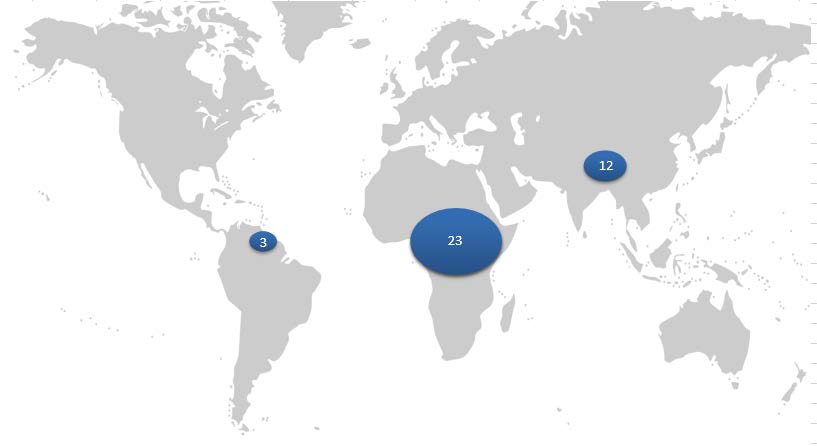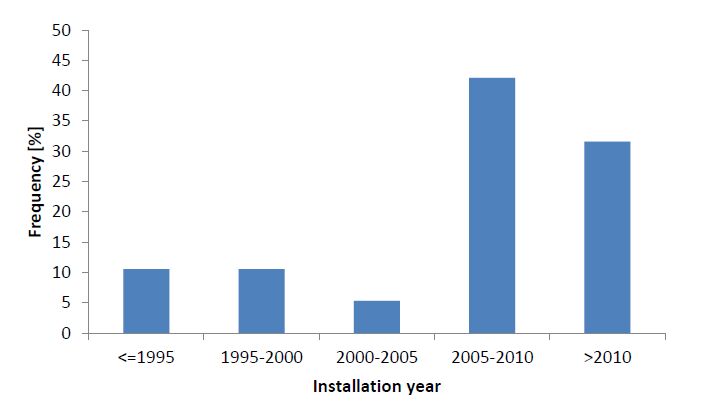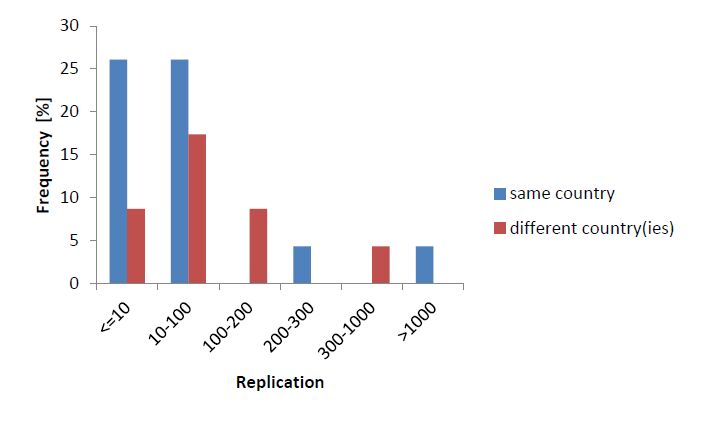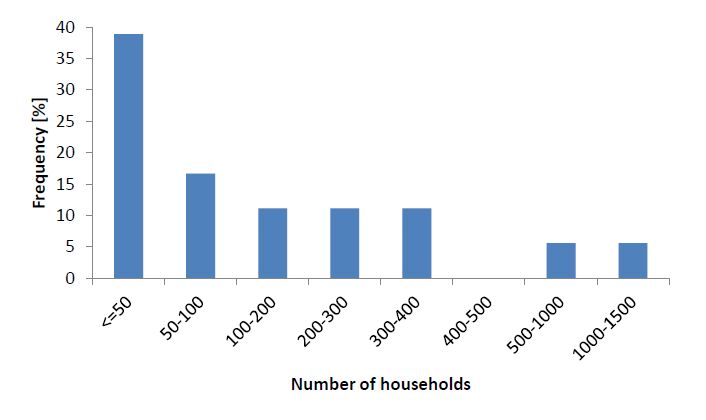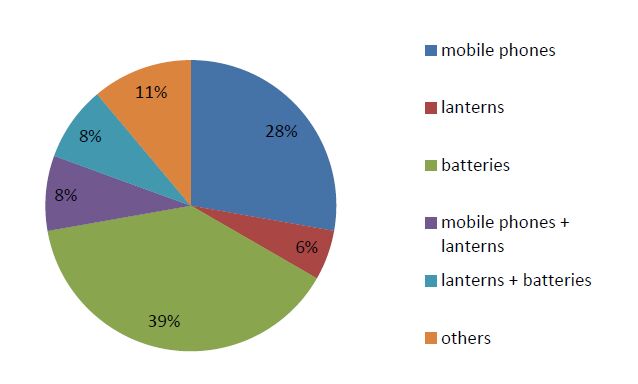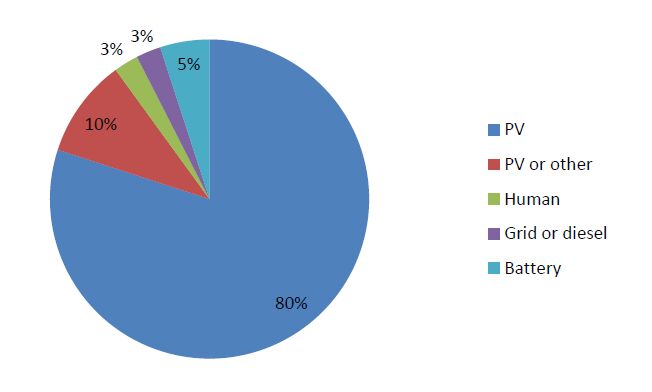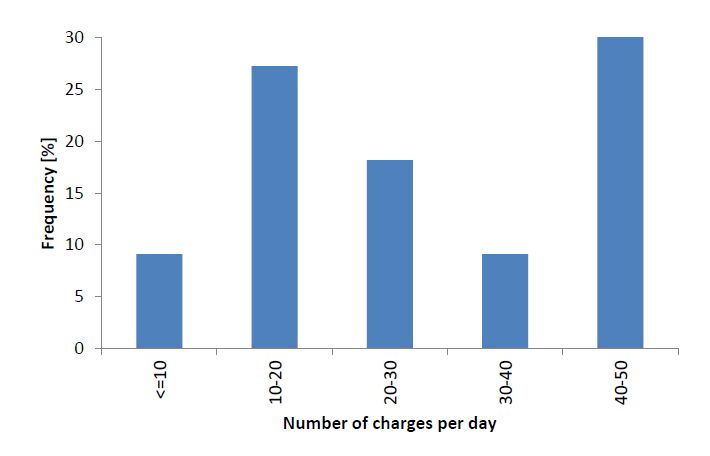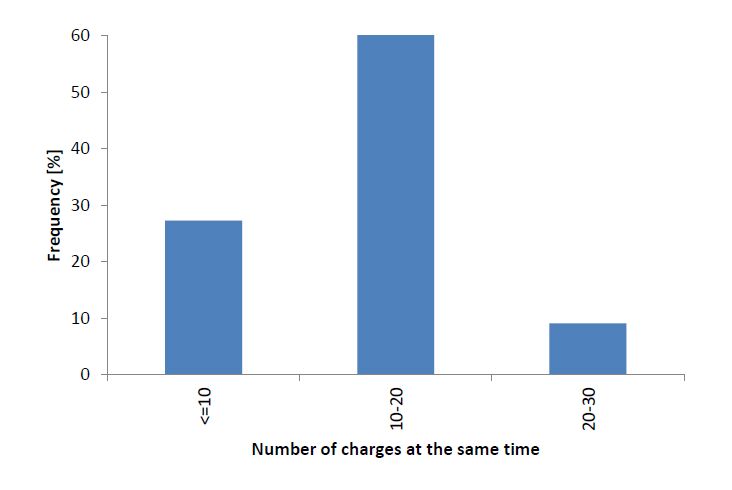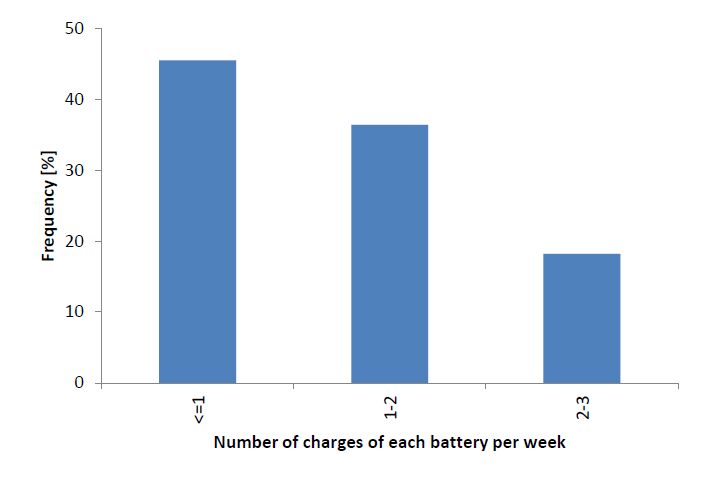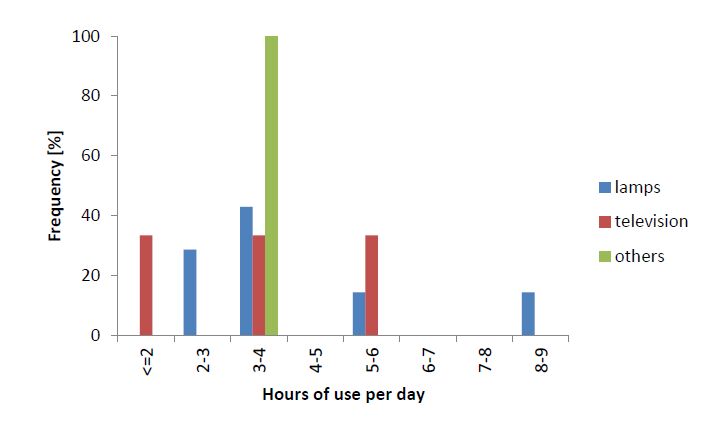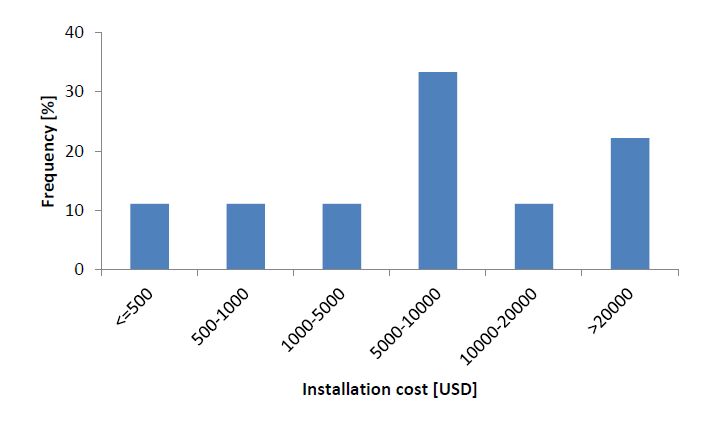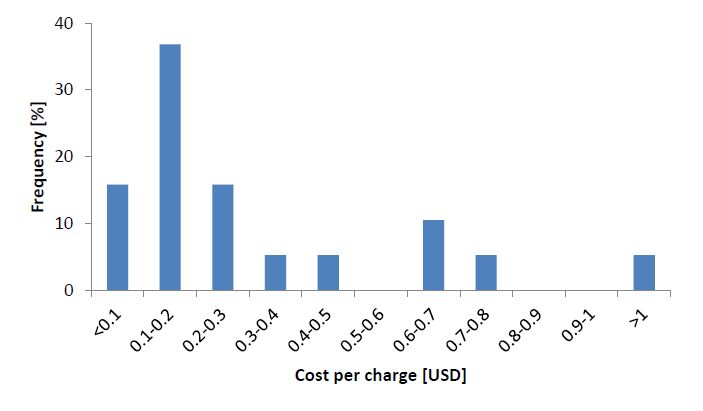Charging stations are an attractive solution to provide access to electricity to low income populations with low energy consumption in remote and off-grid areas. This paper reviews the state of the art of charging stations, with special focus on the technical options. Forty-five different actors in this field were analysed, based on academic publications, reports, online search and surveys. Results show that most stations are run in Sub Saharan Africa and South Asia, are powered by solar energy and although there are many different energy services targeted, the most popular services are charging batteries, mobile phones and lamps. The first charging station was installed in 1992 but most activities happen after 2005. This recent growth has been enabled by the falling cost of photovoltaic modules, learning effect, economies of scale, financial innovation, private sector involvement and worldwide dissemination of mobile phones. While in the first system the only purpose was to charge solar photovoltaic lanterns, the first multi-purpose station appeared in 2008. As expected, the technical challenges are mostly related to the use of batteries not only because they represent the component with shortest lifetime but also because if the battery is not for individual use, social questions arise due to poor definition of rights and duties of the customers. Furthermore, the development of a sustainable business model is also a challenge since this requires technical skills and system monitoring that are not usually available locally. Finally, it is also suggested that the minimum technical quality standards for charging stations should be defined and implemented.
1.
Introduction
Banks create liquidity by financing relatively illiquid assets with relatively liquid liabilities. This is a crucial reason why banks exist and a necessary component for the growth of economy [1,2]. More specifically, this financial intermediation role of banks has proved to be not only the most fundamental function of banks but also a strong determinant of capital allocation and economic growth [3]. However, excessive liquidity creation essentially reduces the liquidity level of banks, strengthen the maturity mismatch between long-term assets and short-term liabilities and exposes them to illiquidity risk, which is a major source of bank runs. Past experience has empirically proven that pre-crisis disorderly liquidity creation leads to asset bubbles and lays great potential for the spread of crisis [4,5]. As the modern financial system develops and interbank linkages become closer, banks' liquidity creation activities have to take into account the impact of externalities from other banks. Among these externalities, the interbank market occupies a very important position, allowing banks to mitigate liquidity crises with short-term borrowing, but also facilitating the contagion of illiquidity risk. We examine the impact of their position in the interbank market on their liquidity creation.
Considering the importance of bank liquidity creation, an emerging body of empirical literature examines it. The pioneering work is done by [2]. Subsequent study can be roughly divided into two categories: One is to examine interplay between liquidity creation and macro-economic factors [4,5,6,7,8,9,10], and the other is to explore the relationship between internal bank factors and liquidity creation [11,12,13,14,15,16]. The former type of literature mainly focuses on how bank liquidity creation is affected by systemic events or how it affects systemic stability. The latter type investigates how specific bank characteristics influence individual bank liquidity creation. The common goal of both strands is to enhance the stability of the financial system by providing a deeper understanding of liquidity creation. Therefore, a natural question that arises is: What connects these two strands? A potential answer is the interbank market, which plays a crucial role in transmitting risk throughout the system and motivating much of the policy action during and after the crisis from a macro perspective and in managing liquidity mismatches among individual banks from a micro perspective [17,18]. However, few studies on liquidity creation consider this important factor.
Following the global financial crisis that started in 2007, there has been increasing recognition of the importance of study interbank linkages from a network perspective for prudential supervision [19]. As Diamond and Dybvig argue in [1], banks are inherently vulnerable and they establish close peer connections through interbank lending and borrowing to enhance their stability and efficiency [20,21,22,23,24,25]. Through the interbank market, liquidity can flow from banks with idle liquidity to banks in urgent need of liquidity, redistributing liquid assets and improving the efficiency and stability of the banking system, thereby forming the interbank network. The structures of such networks are not random, but reflect the collective dynamics of all agents in the system, driven by their strategic behavior. Previous studies have confirmed that lending network structure is strongly correlated with bank specialization, performance and balance sheet data [20,26,27]. Given that the position of a bank in lending network may reflect the banks liquidity management and basic characteristics, how does it affect the liquidity creation, the most fundamental function of banks? Our aim of this paper is to empirically address this question.
To tackle this issue, an understanding of channels that the interbank market influences liquidity is a necessity. As discussed above, banks are also exposed to the risks associated with declining liquidity levels when they create liquidity. Therefore, the interbank lending network, as a key channel for transmitting liquidity risk, may affect banks liquidity creation through the following mechanisms. In terms of direct links, more interbank borrowing may make banks more cautious about liquidity management because of its higher cost. Conversely, more interbank lending may reduce liquidity buffers and increase risk exposure, but also signal more optimistic business expectations, more robust capital structure or higher interest income, which may enhance liquidity creation [13,20,28]. In terms of network structure, the increasingly complex links and dependencies between banks also affects the cost (benefit) to the bank of obtaining (lending) liquidity and risk management, thus influencing liquidity creation. For example, existing studies have found that banks borrow from lenders with a wide network of lenders at a lower cost and lend to borrowers with more lenders at a higher rate [20,29]. Moreover, illiquidity also spreads between banks in the form of networks. Despite the growing recognition of interconnectedness as a key feature of the banking system, the precise effect of the interbank network on individual bank liquidity creation remains poorly understood [30]. To fill this gap, we use lending networks to investigate this issue [31].
We analyze how the interbank network structure relates to liquidity creation. To identify the network structure, we introduce three network centrality indicators: hub ($ HUB $), authority ($ AUT $), closeness centrality ($ CLO $). The liquidity creation of banks is described by the measures proposed by [2]. We analyze a sample of 1406 banks from 29 countries, which can be subdivided into euro and non-euro areas. Banks in the Eurozone have lower transaction costs than banks in other countries, but they also have less policy autonomy, which may affect their liquidity creation [32,33]. To examine the impact of Eurozone membership on bank liquidity creation, we split the sample into two subsamples and run regressions. Moreover, because of the different capital adequacy ratios and business models, banks' risk control and liquidity management strategies will also differ thus leading to different ways that lending networks affect liquidity creation [2,15,34]. Therefore, we introduce two dummy variables for analysis. Our analysis enables us to have a more comprehensive understanding of bank liquidity creation, which would help regulators to analyse bank liquidity risk more deeply.
Our paper contributes to the literature in two ways. First, it enriches the relatively scarce literature on bank liquidity creation, which has not received adequate academic attention despite being one of the key reasons for the existence of banks [4]. Second, it examines how network structure, a factor often neglected, affects bank liquidity creation. To the best of our knowledge, this is the first empirical study of interbank network impact on liquidity creation. While Choi et al. and Beladi et al. have documented the impact of banking partnership and interbank market failures on liquidity creation respectively, we take the network structure and the direction of the loan into account and obtain some new findings [28,35]. Furthermore, we extend the work of Ardekani et al. in [20] by analyzing dynamic liquidity creation rather than static liquidity levels. In general, our results also provide new evidence that the position of banks in the lending network affects the liquidity creation of individual banks, thus informing the macro-prudential supervision of banks.
The remainder of the paper is organized as follows. Section 2 introduces the data, method and definitions of variables. Section 3 presents empirical results. Section 4 verifies the robustness of the results. Finally, we summarize the conclusions in Section 5.
2.
Related literature
The role of banks in creating liquidity and stimulating economic growth has a long history, tracing back to Adam Smith, who highlighted the importance of liquidity creation by banks and illustrated how it helped Scottish business. The central role of banks as liquidity creators remains crucial in modern financial systems [1,36]. Based on the theoretical literature, Berger and Bouwman propose a comprehensive empirical measure of liquidity creation and examine its relationship between bank capital [2]. We initiate the empirical study of liquidity creation and further strengthens the interest of researchers and policymakers in this topic. Building on these measures, an emerging body of literature explores a range of topics from the relationship between liquidity creation and macroeconomic factors to the the main determinants of liquidity creation.
A body of literature has examined the relationship between macro factors and liquidity creation. Some research exam how the liquidity creation influences systemic risk and they find the level of liquidity creation is of great importance for financial stability and prudential supervision [4,6,7]. Berger and Sedunov find that the bank liquidity creation has a statistically and economically significant positive relationship with real economic output [37]. Kapoor and Peia test whether the banks that benefit more from the quantitative easing create more liquidity [9]. The effects of the regulatory interventions and capital bailouts on banks liquidity creation are studied by [8]. Chatterjee finds that banks create less liquidity after recessions [10]. Boubakri et al. investigate the effects of national culture on bank liquidity creation and finds that individualism promotes mobility creation [38]. Lee et al. explore the impact of climate risk on liquidity creation [39].
Given the importance of liquidity creation, another body of literature has examined its determinants. Díaz and Huang examine how the internal bank governance influences the liquidity creation of banks in the US [11]. Baltas et al. verify the cost efficiency-liquidity creation hypothesis, i.e., the more cost-efficient a bank is, the more liquidity it creates [12]. Huang et al. show that the banks with optimistic CEOs create more liquidity[13]. The impact of bank business models on individual liquidity creatio is analyzed by [15,40,41]. Jiang et al. examine how do different types of bank competition affect liquidity creation respectively in [16]. Tran et al. find that after controlling for bank profitability, banks' capital levels and liquidity creation reinforce each other [14].
3.
Sample, method and variables
This section presents the reasons for choosing the European banking sector as our sample first. Then, the method to construct lending networks is introduced and we provide a simple description of the panel regression model. Lastly, we describe all the variable involved.
3.1. Sample description
We examine the liquidity creation of the European banking sector after the first enactment of Basel Ⅲ. The European Union (EU) has been one of the three largest economies in the world in the past decade, and the liquidity problem of its banks has attracted the attention of market participants and bank regulators [42]. Furthermore, the European banking sector has relatively lower quality of loan portfolios and higher interconnectedness with other parts of the global financial system than other regions, which makes its liquidity creation issues more critical and challenging [42,43]. Prior to the enactment of Basel Ⅲ, banks typically adopt more aggressive liquidity management, which contributes to the global financial crisis. We aim to make our study more relevant and instructive, and focus on the impact of interbank networks on banks' liquidity creation under the Basel Ⅲ framework. The liquidity standard introduced by the Basel Committee in 2010 immediately affected banks actions before its full implementation [44]. Therefore, our sample period covers the years 2010 to 2021.
Specifically, our sample covers of commercial, investment, and real estate and mortgage banks from 29 European countries between 2010 to 2021 (Austria, Belgium, Bulgaria, Croatia, Cyprus, Czech Republic, Denmark, Estonia, Finland, France, Germany, Greece, Hungary, Ireland, Italy, Latvia, Lithuania, Luxembourg, Malta, Netherlands, Poland, Portugal, Romania, Slovakia, Slovenia, Spain, Sweden, Switzerland and the United Kingdom). We exclude savings, mutual and cooperative banks because they mainly trade with their own central institutions in the system, which is inconsistent with the assumption of the minimum density method. We will examine the robustness of our results by including these types of banks in subsequent sections [20,45]. We prioritize the consolidated balance sheets but use unconsolidated data when the former are not available.After removing banks with missing data on total assets and interbank lending and borrowing from Bankfocus (https://bankfocus.bvdinfo.com) and trimming the sample by removing the lowest and highest one percent of the observations of all variables to reduce the effect of outliers, we obtain a final sample of 1406 banks.
3.2. Network reconstruction
Banks do not disclose the granular data required needed to model realistic bilateral relationships due to confidentiality reasons. Hence, we simulate the lending-borrowing matrix using algorithms to preserve important characteristics of the original interbank market. Banks tend to minimize their business partnership to reduce the costs of information processing, risk management and credit checks [20,31]. The minimum density (MD) algorithm identifies the most probable links and assigns them the largest possible exposures, combining information-theoretic arguments with economic incentives. This approach fits the real situation closely so it's used in a lot of high level literature [20,46,47,48,49].
The MD method aims to minimize the number of links in a system where the total amount of interbank borrowing and lending by the banks is known. Assuming that c is the fixed cost of establishing a connection, we can formulate the MD method as a constrained optimization problem for matrix $ \mathbb{Z} $:
where $ A_{i} $ is the interbank lending of bank $ i $ and the $ L_{i} $ is the interbank borrowings. The function $ {\bf{I}} $ indicates whether bank $ i $ lends to bank $ j $, taking the value one if it does and zero otherwise. The specific calculation method is described in [31].
Figure 1 synthesizes the network diagrams for Germany, the UK, France, and some major country in our sample for 2010 and 2021. The codes in the diagram denote the banks in the country, while edges with arrows in the diagram represent the direction of borrowing and the thicknesses represent the number of loans after normalization [50]. All these diagrams are drawn from the Fruchterman Reingold layout in Gephi software.
3.3. variable
3.3.1. Dependent variable
Berger and Bouwman propose four novel measures of liquidity creation: $ catfat, catnon, matfat $ and $ matnon $ [2]. These measures can be computed following their three-step procedure and the required data can be obtained from publicly datasets. First, on- and off-balance sheet items are classified as illiquid, semi-liquid or liquid according to the cost and time for banks to obtain liquidity to meet customer needs or for customers to withdraw from the bank. Second, different weights are assigned to the items categorized in the first step. Based on the modern financial intermediation theory, banks create liquidity by financing illiquid assets with liquid liabilities and consume liquidity when they finance with illiquid liabilities and equity. Therefore, liquid liabilities and illiquid assets are assigned to positive weights while illiquid liabilities, equity capital and liquid assets are weighted negatively. Similarly, off-balance sheet items are also weighted by this principle. Lastly, the liquidity creation measures are calculated by multiplying each item and its weight.
As Berger and Bouwman argued in [2], the ability to securitize loans applies more to the focus of the definition of liquid assets (i.e., the cost and time for banks to liquidate assets) than the time until self-liquidation. Therefore, classification based on loan categories ($ cat $) is above the priority of which based on maturity ($ mat $). Moreover, the difference between fat and non is that fat takes off-balance sheet items into account while non does not. In summary, we use catnon as our dependent variables (the regression coefficient between catfat and the lending network centrality indicator is insignificant, suggesting that there is no strong correlation between bank off-balance sheet liquidity creation and a banks position in the lending network. Therefore, we omit it from the subsequent analysis in the paper). To make our liquidity creation measures comparable, each bank's liquidity creation are normalized by its total assets [2].
3.3.2. Network variable
Network centrality variables can be calculated in different ways to capture various dimensions of the network. Our paper introduce the following network variables as independent variable to augment traditional bank liquidity creation models and ensure the robustness of our empirical study: $ HUB, AUT, CLO, HUB $ and $ AUT $ is calculated by HITS algorithm and they separately dig out the dominant link senders and receivers in the directed network [51]. $ CLO $ indicates the accessibility of a bank on the entire network.
The HITS algorithm, originally designed for internet information retrieval, calculates $ HUB $ and $ AUT $ scores of web pages [51]. The algorithm is based on the idea that there are two types of pages within the web: authority pages, which have many incoming links from other pages, especially hub pages; and hub pages, which have many outgoing links to other pages, especially authority pages. A page with a high authority score is linked by many pages with high hub scores, and a page with a high hub score links to many pages with high authority scores. In lending network, the $ HUB $ and $ AUT $ identify the dominant lenders and borrowers in the network. $ HUB $ ($ AUT $) not only measures the importance of each banks total number and amount of direct borrowers (lenders) in the network but also considers the strength of its direct borrowers (lenders) based on their borrowing (lending) relationship [20,51]. The iterative procedure involves estimating eigenvalue centrality on two modified versions of the original adjacency matrix:
$ CLO $ is measured by the inverse of the sum of the shortest distances between one bank and all other banks in a network. It captures the to what extent bank $ i $ can have impacts to other banks more directly with less distance [52,53]:
where $ d_{i j} $ is the shortest distance between bank $ i $ and bank $ j $. Banks with high $ CLO $ can facilitate the spread of illiquidity and shocks.
3.3.3. Control variable
To focus on the network centrality and avoid the potentially confounding effects on liquidity creation, we include some variables known to influence bank liquidity creation as control variables. Generally speaking, we control for two levels of factors: bank-level and country-level. For one thing, at the bank-level, capital ratios are found to have a significant impact on liquidity creation in the seminal empirical literature by [2], so total capital adequacy ratio ($ TCR $) is introduced. Then, we employ cost to income ratio ($ CIR $) as proxy of bank cost efficiency [12]. Furthermore, we introduce return on total assets ($ ROA $) and net interest margin ($ NIM $) to describe the profitability of banks[14]. Finally, we select the total asset growth rate ($ TAGR $) and natural logarithm of bank gross total assets ($ LnTA $) to control the impact of size growth and size. For another, at the country-level, previous literature has confirmed that national economic development promotes bank liquidity creation [37], therefore, we introduce the growth rate of $ GDP $ ($ GDPgr $) as a control variable. We also take $ CPI $ to control the effect of inflation [20].
Table 1 reports descriptive statistics for our variables. The bank- level data is from Bankfocus database and country-level data is available from the Wind database. Table 2 summarizes the correlations between the independent and dependent variables. One can see that our network measures are significantly but not strongly correlated, which justifies our use of multiple network variables in separate regressions.
4.
Empirical analysis
We examine the linkage between network centrality and liquidity creation by the following fixed panel regression model:
where the dependent variable $ Liquidit\_creation_{i, t} $ is the liquidity creation($ catfat $ or $ catnon $) of bank $ i $ in year $ t $. $ \alpha_k $ ($ k = 0, 1, 2, 3, 4 $) are constants. $ NET_{i, t} $ the network variable includes authority, hub, closeness centrality and clustering coefficient (although the variable capture the different dimensions of network, they are highly correlated. So we will separately introduce them in the regression). $ B_{i, t} $ is a set of bank-level control variables including $ Tcr $, $ Cir $, $ Nim $, $ Tagr $, $ Tagr $ and $ CPI $. $ C_{i, t} $ are two country-level control variables consist of $ GDPgr $ and $ CPI $. In order to account for time-invariant unobserved heterogeneity and bias due to potentially omitted variables, our regression takes $ \mu_i $ to to control bank fixed effect. Also, time fixed effect, $ I\cdot year $, is allowed for to time-varying unobservable variables which have possible systemic effects on the level of liquidity creation. $ \varepsilon_{i, t} $ is an error term, we use robust standard errors and cluster it at bank level.
4.1. Regression results of lending network centrality on liquidity creation
Table 3 presents the regression results of the effect of lending network centrality on on-balance sheet liquidity creation. Our findings highlight that banks with higher values of $ CLO $ tend to create less liquidity, as captured by the positive coefficient at $ 10% $ significance level on the $ CLO $. A plausible explanation is that the banks with higher $ CLO $, which means higher accessibility to other banks in the network, intuitively embodies more contractual relationships. It brings significant additional risk control, credibility checks and financing costs, thereby reducing the bank's ability to create liquidity [28]. In addition, our simulation networks enable us to conduct a more detailed study based on the direction of the loan. The negative coefficient at $ 5% $ significance level between liquidity creation and $ AUT $ confirms that the more dominant borrower the bank is in the network, the less liquidity it creates. Banks that lack a stable source of liquidity, especially small and medium-sized ones, often pay high interest rates in the interbank market to cover shortfalls. This makes them more cautious in managing their liquidity position and reduces their liquidity creation [54]. Correspondingly, $ HUB $ is positively correlated with liquidity creation. In other words, a more dominant lender creates more liquidity. This could be because it has more relaxed liquidity management and more optimistic expectations of the outlook, thus creating more liquidity [13,29,35]. Furthermore, we also regress liquidity creation using simple network centrality indicators such as out-degree and in-degree(the number of borrowers and lenders with whom a particular bank has direct transactions), out-strength and in-strength(the total amount of loans versus total borrowings by a particular bank), but none of the regression coefficients are significant. This may indicate that bank liquidity creation depends not only on direct interbank transactions, but also on the interbank network structure.
4.2. Euro area and non-Euro area
A distinctive feature of our sample is the existence of the euro monetary union, which implies more interbank connections and fewer policy options for the Eurozone member countries than for those with their own independent currencies. This may have a significant impact on bank liquidity creation. To examine whether this factor affects the relationship between network centrality and liquidity creation, we split our sample into Eurozone and non-Eurozone subsamples. Table 4 shows that $ HUB $ has a positive and significant correlation with liquidity creation of banks in the Eurozone, while $ AUT $ has a negative and significant effect on liquidity creation of banks in the non-Eurozone countries, both at the 1% level. This result suggests that joining or not joining the euro monetary union has a substantial influence on liquidity creation. As [33] argue, the common currency facilitates interbank lending within and across countries, leading to a dramatic increase in interbank lending by Eurozone banks. Therefore, the greater accessibility of interbank lending allows banks to ease their prudent management of liquidity, which leads to a less pronounced tendency for the dominant borrowers in the network to reduce their liquidity creation. In addition, the Eurozone members are closely interconnected and a systemic liquidity problem in one region could have catastrophic consequences if unchecked. Therefore, bailouts may be inevitable to maintain financial system stability. This expectation can in turn trigger moral hazard and make banks act more aggressively [32]. This explains why $ HUB $ is only significant in the Eurozone subsample.
4.3. The capital moderating effect on the relationship between network topology and bank liquidity creation
Bank capital is one of the most important regulatory indicators of bank risk and has been shown to affect the banks ability to create liquidity in the previous literature [2,14,55]. In order to investigate whether banks with different capital ratios have a similar propensity to create liquidity when they are in the same position in the lending network, we introduce $ High\_{cap}_{i, t} $, which equals one if bank $ i $ has an above-median total capital adequacy ratio in year $ t $ and zero otherwise. We include the interaction between this dummy variable, also used as a control, with the network centrality to assess its moderating effect on the influence of banks with different capital ratios on a banks liquidity:
the impact of network centrality on liquidity creation of below-mean capital bank is captured by $ \alpha_1 $ and the above-mean capital bank is captured by $ \alpha_1+\alpha_2 $
Table 5 summarizes the result of Eq (4.2). The coefficient of $ AUt $ and $ CLO $ remains negative and statistically significant across the alternative estimations. Concerning the interaction effects, the positive and statistically significant coefficient of $ AUT_{i, t}\times High\_{cap}_{i, t} $ indicates that the negative relationship between network centrality ($ AUT $ and $ CLO $) and liquidity ratio is attenuated for banks with higher capital. This result implies that when the borrowing status in the network rises, banks with higher capital ratios reduce the amount of liquidity creation by less compared to banks with lower capital ratios. This preliminary evidence supports the risk absorption hypothesis: higher capital enables banks to create more liquidity while maintaining their stability, despite higher borrowing costs [2].
4.4. The business model moderating effect on the relationship between network topology and bank liquidity creation
Traditional banks focus on deposit and loan businesses to earn interest rate spreads, while investment-oriented banks earn more non-interest income. Previous studies suggest that bank business models are generally heterogeneous, with varying risk preferences, investment horizons, and monitoring intensities among them [15,34]. Moreover, because a move into non-interest segments may destroy bank liquidity creation, The impact of the interbank market on liquidity creation may therefore vary depending on the business model of the bank. According to [34], we take the share of non-interest income in total operating revenues to describe bank business model. A substantial proportion of revenue derived from non-interest sources indicates a higher degree of diversification into non-traditional activities. We introduce $ High\_NI_{i, t} $, which takes on the value of one if bank i has an above-median non-interest income to operating revenues in year t and zero otherwise. The specific model is as follows:
Table 6 shows the result of Eq (4.3). The positive relationship between $ HUB $ and NSFR is attenuated for banks with higher non-interest income to operating revenues, which represents that banks with more non-traditional business create less liquidity when they are in the same lending position in the network. Banks that benefit from a more diversified portfolio may also suffer from their reliance on riskier assets. Therefore, even if their lending levels are similar, they would not have the same level of optimism and reliance on earnings from liquidity creation as those banks with higher interest income as a percentage of total operating income. This leads to a lower incentive to create liquidity.
5.
Robust test
5.1. Test of endogeneity
We take further measures to examine endogeneity, which may arise from omitted variables or reverse causality. We are concerned with how banks position in the interbank market relates to their liquidity creation, but interbank lending and borrowing is itself part of the liquid assets and liabilities in the liquidity creation measure, which may cause some reverse causation problems. Therefore, to address the potential endogeneity problem, we adopt two-stage least squares (2SLS) estimation. In the first stage, we regress our independent variable of network centrality on the instrumental variables: pagerank in lending network and non-performing loan ratio ($ NPL $). Pagerank is a classic network indicator that correlates highly with other network indicators. It does not correlate significantly with bank liquidity creation in our empirical analysis, which makes it a suitable instrumental variable. Furthermore, $ NPL $, a variable not statistically significantly correlated with liquidity creation, affects bank's position in the network [56,57]. Table 7 shows that our instrumental variables pass underidentification test, weak identification test and hansen-j test.
5.2. Network constructed with all types of banks
For the reason that the savings banks, mutual banks and the cooperative banks could both be described as being relatively closed systems [20,45], we include them in the reconstructed lending network for robustness tests instead of adding these banks to the main results. Table 8 shows that our results remain the same.
6.
Conclusions
To account for bank liquidity creation, the current research works mainly focus on macro policy or internal bank factors. However, there is a lack of literature on how interbank networks influence bank liquidity creation. This is a significant gap for the regulators and policy makers who need to think at a system level, given that the interdependence of the financial system has become conventional wisdom.
Based on the interbank lending data from commercial, investment and real estate and mortgage banks in 29 European countries from 2010 to 2021, we construct 12 annual networks using the MD algorithm. Then we regress three different centrality on liquidity creation measures and find that only on-balance sheet liquidity creation is significantly associated with network centrality. Due to the presence of a special monetary union in our sample, we split the sample into two subsamples, euro area and non-euro area, for grouped regressions. Subsequently, we investigate the role of bank capital and business model in moderating the relationship between bank liquidity creation and the network topology centrality. The empirical results are as follows:
● (Ⅰ) Dominant borrowers with high value of $ AUT $ tend to reduce liquidity creation because of their prudent liquidity management and high funds cost. Conversely, major lenders with high $ HUB $ will create more liquidity due to their lax liquidity management and optimistic future expectations.
● (Ⅱ) In the euro area subsample, only $ HUB $ is significant, while in the non-euro area subsample, only $ AUT $ is significant. We conjecture that this reflects the lower interbank borrowing costs and higher bailout expectations in the euro area.
● (Ⅲ) Higher capital can mitigate the negative effect of $ AUT $ on liquidity creation, as it provides greater risk absorption capacity which enables banks to create more liquidity.
● (Ⅳ) Banks with more non-interest income create less liquidity than banks with less non-interest income when they have the same value of $ HUB $. These banks have riskier asset portfolios and more pessimistic future expectations than traditional banks.
This paper contributes to the existing literature on the determinants of bank liquidity creation by examining the centrality of lending networks and demonstrating that interbank network positions, rather than bilateral connections, matter for liquidity creation. However, our paper faces some limitations due to its complexity. On one hand, data availability constraints required us to construct our lending network using simulation algorithms, which limits our ability to provide more specific policy implications. On the other hand, this paper focuses only on the interbank market and excludes other linkages. Future research can be optimized in several ways. First, most banks do not publish their NSFR data during our sample period, and future balance sheets may provide more precise liquidity indicators. Second, detailed bilateral data for a specific country could enable a more in-depth study, if available. Finally, future study can apply multiple network approach to capture a more comprehensive description of interbank linkages.
Use of AI tools declaration
The authors declare they have not used Artificial Intelligence (AI) tools in the creation of this article.
Acknowledgments
The authors are grateful to the editor and anonymous reviewers for their constructive comments, which led to a significant improvement of our original manuscript. This work was supported by the National Natural Science Foundation of China (No. 12371159), the Science and Technology Innovation Program of Hunan Province (No. 2023RC1060).
Conflict of interest
The authors declare there is no conflict of interest.
Data Availability Statement
The data that support the findings of this study are available from the corresponding author upon reasonable request.










 DownLoad:
DownLoad:


